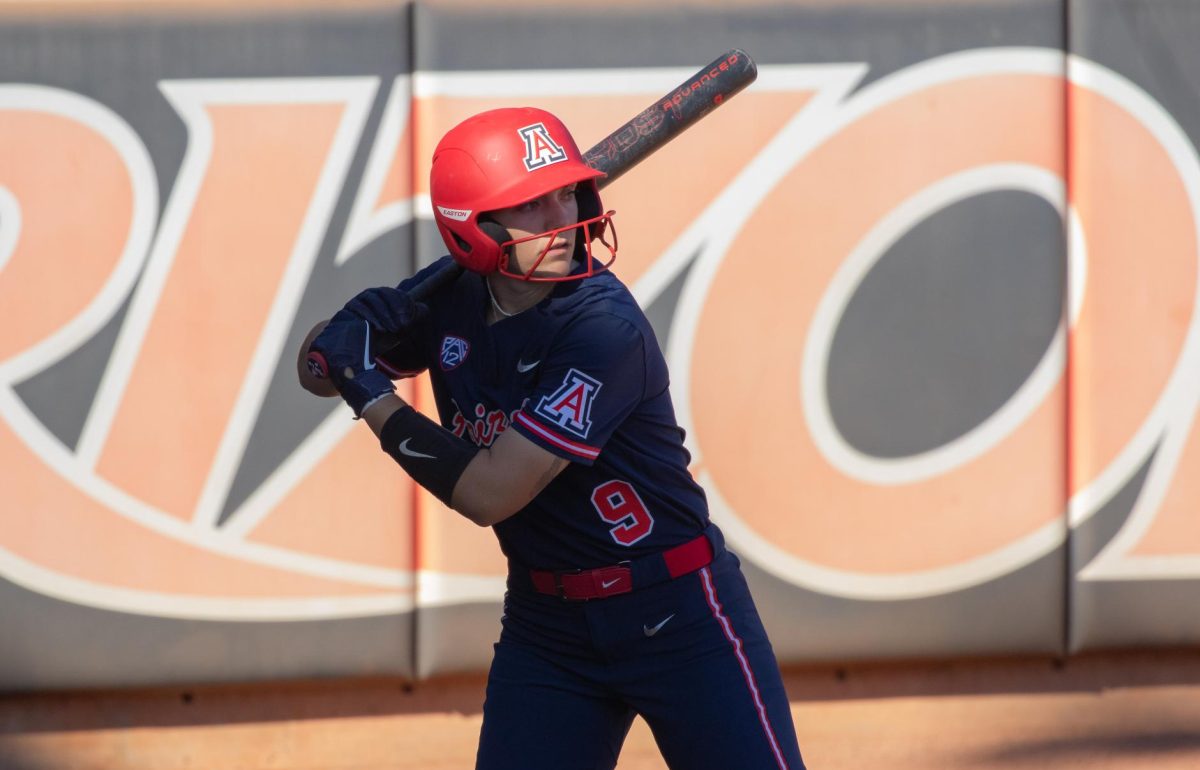Nervousness, anxiety, insomnia and mental issues years into the future are frequent symptoms, yet people continue to flock to the small, tablet-shaped escape called methylenedioxymethamphetamine or MDMA. It has another more commonly known name: Ecstasy. The “”hug drug”” will be the focal point in a new study conducted by UA head of pharmacology and toxicology departments, Terrence Monks.
“”Most research on Ecstasy focuses on the pharmacological, or nontoxic effects of the drug,”” Monks said. “”My interest lies in learning how the drug negatively effects the brain.”” According to the National Institute on Drug Abuse, MDMA is a synthetic, psychoactive drug that produces an energizing effect as well as feelings of euphoria, emotional warmth and distortions in time perception and tactile experiences. The drug is taken orally as a capsule or tablet.
Earlier this month, the National Council on Drug Abuse awarded Monks $1.7 million to study the long-term effects of Ecstasy.
While the drug is commonly found at raves, Kevin P. Conway, Deputy Director of the Division of Epidemiology, Services and Prevention Research in the National Institute on Drug Abuse said taking Ecstasy just once can be problematic.
“”One study in nonhuman primates showed that exposure to Ecstasy for only four days caused damage to serotonin nerve terminals that was still evident six to seven years later,”” he said.
According to the National Institute on Drug Abuse, the effects of Ecstasy include anxiety, restlessness, nausea and panic attacks, among many others. Conway said these symptoms can be particularly harmful to students.
“”It is risky for college students to use Ecstasy, because the problems associated with Ecstasy use can interfere with the ability to sustain concentration and perform well in school. These problems can occur soon after taking the drug or, sometimes, even days or weeks afterwards. In addition, chronic Ecstasy users tend to perform more poorly than nonusers on certain types of cognitive or memory tasks.””
Even though use of Ecstasy has been declining over the past six years, Conway said he is concerned due to the decrease in perceived risk associated with the drug.
“”This lack of concern about the dangers of Ecstasy may foreshadow an increase in actual use in the coming years.””
Hollywood has also added to the allure of Ecstasy, incorporating the drug into several large-budget films such as “”The Girl Next Door,”” “”Garden State,”” “”Bad Boys 2″” and “”Harold and Kumar Go to White Castle.”” In these films, the drug is mostly portrayed as a fun party drug.
“”Over the past years, there has been a general decrease in the perceived risk of harm from Ecstasy among young people. It seems possible that public portrayals of Ecstasy influence perceptions about the drug, which in turn can have a powerful effect on its use,”” Conway said.
One UA student, who wished to remain anonymous, said her first encounter with the drug made her feel like she was going to die.
“”The first time I took it I started getting really hot, and everything starts moving really fast and your vision starts getting really, like, big and bright. You feel really tingly everywhere, and it feels good when people touch you,”” the freshman said.
“”You have to come up the hill and (that’s) when it’s bad and scary. And when you come over the peak, it’s fun and happy time. But coming up that peak the first couple times can be scary,”” she added. “”I’ve never really pictured myself as a girl who would do a drug like that. … I actually did a lot for my first time, I did one and a half pills. I don’t know why I started. I was looking for a new high or something to do. That kind of sounds bad.”” Since first taking Ecstasy, she has taken the drug at least once a week for the past seven weeks.
“”Of course. I know it’s not good for your brain, but at the same time I think people blow it a little out of proportion. I don’t think it does permanent damage. I think obviously, if you do it for a long time it’s going to, but since I’ve just recently done it, if I stop doing it for a couple of months I think that everything would be fine. But I know that it’s not good for you. And of course I’m scared that something bad could happen. But honestly, it would be really … hard to overdose on it; it’s not that kind of a drug. It’s not like painkillers … or anything like that.””
Conway disagrees.
“”Using Ecstasy at all is risky. There are short-term and long-term problems associated with Ecstasy use, and its use with alcohol and other drugs, which is common at raves, is even more dangerous. Remember, nobody ever plans to develop a drug problem. And all drug problems start with casual use.””
Finding treatment
For students who have been involved with any type of substance and are looking for help to deal with the drug, Campus Health offers several types of programs.
“”What we have is brief treatment here … what people would do (is) walk into triage and … see a counselor for free. Then you would talk to the counselor and get a brief evaluation of what your needs are, and then you and the counselor would discuss where those needs could be met,”” said Lynn Reyes, Campus Health alcohol and other drug prevention specialist. If it is a service not provided at Campus Health, then the student would be referred to someone in the community, Reyes said. “”Or perhaps to one of your insurance providers.””
If a student goes to Campus Health asking for help with a drug addiction, depending on the individual circumstances, Campus Health has limited options.
“”If it is a long-term type of treatment, then it is something that we’re going to refer out because, like I said, we’re a brief treatment center. We don’t have inpatient, we don’t have detox here for substances … so some of those non-brief services would be referred out,”” Reyes said.
Campus Health can also offer substance abuse programs that work in conjunction with students’ insurance.
“”We actually can point people in the right direction here so that they wouldn’t have to go (to UMC) and … based on what a person’s needs are. So if a person needs inpatient, then we’re obviously going to refer them to some detox center and … work with the student’s insurance provider,”” Reyes said.
Yet if a student does not have insurance, Reyes said treatment centers locally can help.
“”So what we try to look at is do they need detox, do they need inpatient, do they need outpatient, do they need intensive outpatient? Or will weekly counseling suffice?””
All of these needs are determined through counseling, she added. While Reyes is not sure of the actual number of cases referred to the community, she said Campus Health is busy.
“”We get over 500 students a year – that’s for alcohol and marijuana. That’s the education program. The treatment program I don’t have the exact number … we’re pretty busy all day every day.””
Tackling drugs on campus
While the presence of Ecstasy and treatment options point to drugs being a problem on campus, Sergeant Juan Alvarez, University of Arizona Police Department Public Information Officer said it is still a small percentage.
“”If you look at the context of the numbers of arrests we have or violations in relation to the population that we have, it still is a relatively small number. But the fact is that students use … drugs. It’s a problem that we would like no students using illegal substances.””
According to the UAPD Campus Safety and Security Report, drugs arrests from 2006 to 2007 have gone up 75 percent. Alvarez said that number also contains traffic stops off-campus that have resulted in arrests for drug or paraphernalia possession.
“”You know often times we catch people who are stealing bikes and we take them into custody, we will find narcotic paraphernalia on them: syringes, packaging material. … It may not be directly attributed to students, it may people who are coming from outside of the university community to commit crimes on campus.””
If a student is found with drugs or paraphernalia on them, there are several options offered. But that depends on the drug.
“”If it’s a misdemeanor … we find a small amount of marijuana, maybe a pipe, a plastic baggie with a little bit of marijuana in it, then we have the option, if the student is willing, to have that case diverted to the Dean of Students’ office. And then in that case, the Dean of Students Office will look at the case, look at the student’s past history and decide (what) type of support is best needed for the student.”” Alvarez said.
He added that support could range from additional counseling to academic probation or even community service.
“”It all depends on what the Dean of Students feels is appropriate. Once they complete the diversion program, it’s like they were never arrested. … If it is a narcotic drug like meth, cocaine, heroin or Ecstasy, it is considered a felony and they have to get booked into the court. They get arrested … and then the court deals with it.””









